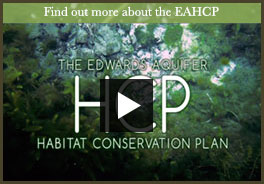About EAHCP
The Habitat Conservation Plan (HCP) is intended to provide assurance that suitable habitat for covered species will remain in both the San Marcos and Comal Springs.
Through a stakeholder driven process, the Edwards Aquifer Recovery Implementation Program recommended that the Edwards Aquifer Authority, the City of San Antonio–represented by the San Antonio Water System, the City of San Marcos, the City of New Braunfels, and Texas State University apply for an Incidental Take Permit (ITP) under the Endangered Species Act.
All projects outlined in the HCP are designed to provide overall benefit to the springs systems and the species that inhabit those springs through the three major project categories:
The ITP was granted by the U.S. Fish & Wildlife Service in order to allow the permittees a specified level of disturbance in the system in the understanding that a variety of mitigation measures will be implemented.
For additional information, please see our FAQ page.
For annual work plans, please see our Work Plan page in the EAHCP Documents Library.
